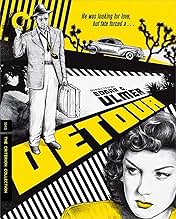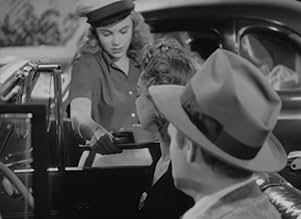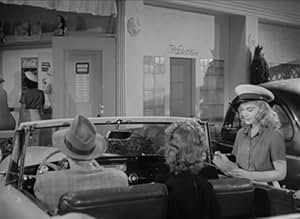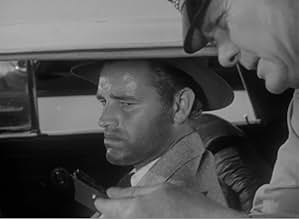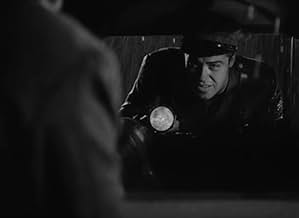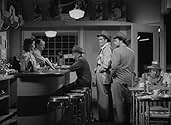अपनी भाषा में प्लॉट जोड़ेंThe life of Al Roberts, a pianist in a New York nightclub, turns into a nightmare when he decides to hitchhike to Los Angeles to visit his girlfriend.The life of Al Roberts, a pianist in a New York nightclub, turns into a nightmare when he decides to hitchhike to Los Angeles to visit his girlfriend.The life of Al Roberts, a pianist in a New York nightclub, turns into a nightmare when he decides to hitchhike to Los Angeles to visit his girlfriend.
- पुरस्कार
- कुल 1 जीत
- Used Car Salesman
- (बिना क्रेडिट के)
- Cop
- (बिना क्रेडिट के)
- Tony - Used-Car Lot Mechanic Inspecting Car
- (बिना क्रेडिट के)
- Nightclub Patron
- (बिना क्रेडिट के)
- California Border Patrolman
- (बिना क्रेडिट के)
फ़ीचर्ड समीक्षाएं
The story feels more than a little strained on more than one occasion. It's hard not to fall in love the hopelessness that constitutes Detour. A low-budget thriller directed by Edgar G. Ulmer. Sure, it's an extremely simple B-movie, but it is packed full of interesting quotes, friendly cynicism, pitch black darkness and at least as much rain. It is insanely entertaining to see Vera and Al throw sharp barbs at each other while the tones are so miserable that they find it hard to laugh at them.
With a playing time of over 70 minutes says Detour goodbye long before it has time to start to feel tiring.
What makes "Detour" a must see, is the clever way its narrative unfolds on the screen. Al and Sue are seen first in the small bistro he plays the piano and she sings, in Manhattan. Sue sings a happy rendition of "I Can't Believe You're in Love with Me", and Al shows he can improvise on a theme by Chopin as he jazzes it up. When Sue decides to pack it and move to L.A., Tom promises he'll follow. The tragic mistake he makes is to intent crossing the country hitchhiking. Even in the forties, it's a miracle he made it alive!
In Arizona Al meets the kind Charles Haskell, who happens to be going all the way to L.A. and offers him a ride. The two men develop an easy friendship until the point when Haskell dies of an apparent heart attack. Al disposes of the body and keeps going, assuming now, Haskell's persona. At the nearest gas station he sees a pretty woman, Vera, who appears is hitchhiking, and offers her a ride. This will prove to be his biggest mistake.
Vera turned out to be Al's worst nightmare. She knows Al is not Haskell since she, herself, knows the man. Al ends up a virtual prisoner hiding in the apartment they have rented in Hollywood. He can't escape. When Vera realizes there's a lot of money to be made by having Al pretend to impersonate the dead Haskell, he refuses. She threatens to call the police and he is left on the other room pulling the telephone cord...
The film works because all the elements are in place in this satisfying 67 minutes work and because of the great performances Mr. Ulmer got out of Tom Neal and Ann Savage. Edmund MacDonald and Claudia Drake played Haskell and Sue.
"Detour" was shot in two sets and it shows. It's a small film that doesn't pretend what it's not, and that's basically why audiences seem to like it as it's discovered.
It moves in a seamless manner. The narrator is drawn as we watch into further and further degradation.
The movie has a beautiful look. I'm sure it's a cliché to note this but it resembles a Hopper painting. It also bears the trademarks of Edgar Ulmer's movies: Literate dialogue and classical movie, no matter how low the budget.
Tom Neal is a mournful, appealing protagonist. He's weak, not really bad. Ann Savage, of course, is terrifying as Vera, the hitchhiker from everyone's worst nightmare.
Al's descent from blonde soubrette Sue to consumptive, murderous Vera is terrifying. Yet, though it passes by us quickly, it is fully believable.
"Detour" is a true work of art.
Neal is effective as a man who seems on the surface to be a victim of bad luck and poor judgment. Real bad luck and real poor judgment.
Trying to get from New York to LA by hitchhiking so that he can be with his girlfriend, Al, a talented pianist, is picked up by a guy named Haskell, who, at some point during the ride, dies of we don't know what - probably heart failure. The guy kept taking pills of some sort - my guess is it's digitalis because if it were speed, he wouldn't have fallen asleep.
At any rate, his death leaves Al with a dead body and a car. Feeling no one will believe his story, he hides the body, changes clothes with the victim, takes Haskell's driver's license and money, and leaves. First mistake.
Surely an autopsy would have confirmed the man died of heart failure, number one; and number two, Al in his narration makes reference to the body falling out of the car when he opened the door, indicating that there would then be a bump on the head and he'd then be accused of hitting him.
Uh, Al, I doubt it - the ground was wet and the guy was DEAD. But instead of driving to the nearest police station and explaining what happened, Al takes off.
Later on, he picks up a hitchhiker named Vera. It turns out that she knows he isn't Haskell and uses her knowledge to get him to do what she wants to get more money. If it was downhill in the beginning, now the situation becomes a sheer drop.
There is speculation by viewers that Al is a big fat liar and that his narration, which makes him look like a victim of chance, is skewed, that the facts don't fit his story and that his girlfriend Sue didn't exist.
That is a very interesting way to look at this film, and that conjecture may be true. On the other hand, Al may just be a loser and the victim of bizarre circumstances.
The whole film, and I saw a very grainy print of it, has a bizarre atmosphere. In the New York section, as Sue and Al walk through the streets, there's a fog machine going nuts, giving rise to the conjecture that Sue and Al's romance with her are just in his imagination.
The character of Vera is frightening and pathological; one minute she wants to be treated like a woman by being complimented, and she comes on to Al, and the next, she's threatening him and acting like a shrew. More inconsistencies.
The hard-looking Ann Savage is savage indeed in the role, which is by necessity a quite exaggerated portrayal. Handsome Tom Neal does a good job as Al, and his role includes a substantial narration throughout.
Is this narration what really happened, or is it what he is planning to tell the police if caught? We don't know. The ending was tacked on at the last minute and frankly doesn't feel right.
I like the idea of the ambiguity of the original ending, which matches the ambiguity of the story. The viewer does see this ending, but then it is followed up by another minute of film apparently demanded by the censors.
With Neal's subsequent real-life violent actions and his ultimately being accused of murdering his wife, this film takes on some really macabre aspects.
"Detour" will always remain perhaps the most unusual noir ever produced: made for no money, the strange circumstances of the story, a character who may or may not be lying to the audience, and a leading man who perhaps took his role too seriously. A striking film.
The acting and much of the dialogue is very melodramatic, bordering upon soapy, but it fits the story as so much of it involves conveying the emotion and doing so from the point of view of Al. Bogart and Mitchum wouldn't have been right for this lead role. Either one of them would have come across as either too cool or too tough to put up with such a domineering femme fatale as Ann Savage's Vera and seem so depressed and pathetic. Instead, Tom Neal is perfect as a guy who sees himself bound by fate and doomed.
But maybe the entirety of the story is made up. Al's voice over could just be him sitting in the cafe creating an alibi story. Ann Savage's performance as Vera was over the top maybe because it's Al telling the story, and he wants to make himself look good. I don't buy half of what he tells us; I think he was much more complicit in all of the deaths than he wants the audience to believe. Vera is a caricature of the noir femme fatale because he's trying to convince us that everything was her idea or an accident or fate based on his act of true love - trying to get to his girl in California - and he's completely innocent.
On the technical side, this one showed a great use of light, shadows, and music, and fine direction by Ulmer to keep the mood. It's too bad nobody has restored this one as it resides in the public domain. This is one noir that will stay with you.
क्या आपको पता है
- ट्रिवियाWhile the crew was setting up to film a hitchhiking scene, a passing car tried to pick up Ann Savage (made up to look dirty and disheveled), causing the crew to break out laughing.
- गूफ़In the first shots of Al hitchhiking, the film is reversed. The cars are driving on the wrong side of the highway and the drivers sitting behind the wheel are sitting on the right side of their vehicles.
- भाव
Al Roberts: Money. You know what that is, the stuff you never have enough of. Little green things with George Washington's picture that men slave for, commit crimes for, die for. It's the stuff that has caused more trouble in the world than anything else we ever invented, simply because there's too little of it.
- कनेक्शनEdited into This Is It (2009)
- साउंडट्रैकI Can't Believe That You're in Love with Me
(uncredited)
Written by Jimmy McHugh and Clarence Gaskill
Performed by Claudia Drake
Played often in the score
टॉप पसंद
विवरण
- रिलीज़ की तारीख़
- कंट्री ऑफ़ ओरिजिन
- आधिकारिक साइटें
- भाषा
- इस रूप में भी जाना जाता है
- Zaobilaznica
- फ़िल्माने की जगहें
- 9263 Sierra Highway, Actis, कैलिफोर्निया, संयुक्त राज्य अमेरिका(Vera hitchhiking at Richfield gas station called Actis Service Station)
- उत्पादन कंपनी
- IMDbPro पर और कंपनी क्रेडिट देखें
बॉक्स ऑफ़िस
- बजट
- $30,000(अनुमानित)
- US और कनाडा में सकल
- $16,172
- US और कनाडा में पहले सप्ताह में कुल कमाई
- $5,127
- 2 दिस॰ 2018
- दुनिया भर में सकल
- $16,172
- चलने की अवधि1 घंटा 6 मिनट
- रंग
- पक्ष अनुपात
- 1.37 : 1
इस पेज में योगदान दें


![Trailer [OV] देखें](https://m.media-amazon.com/images/M/MV5BZGEyYTUwNDQtN2ZjZi00YmY2LWE2ZjUtOTY3NjQ3NDQ0Zjg3XkEyXkFqcGdeQXRyYW5zY29kZS13b3JrZmxvdw@@._V1_QL75_UX500_CR0)
